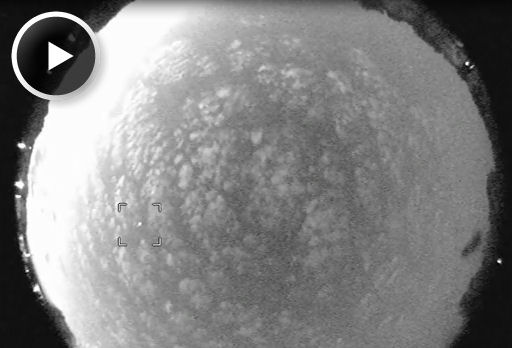PERIGEE "SUPER MOON" ON MAY 5-6: Get ready for moonlight! The full Moon of May 5-6, 2012, is a perigee moon, as much as 14% bigger and 30% brighter than other full moons of 2012. [video] [full story]
METEORS FROM HALLEY'S COMET: Earth is entering a stream of debris from Halley's Comet, source of the annual eta Aquarid meteor shower. The shower peaks this weekend; the best time to look is during the hours before sunrise on Sunday, May 6th. Because the shower's radiant is located below the celestial equator, southern hemisphere observers are favored, but even northerners should be able to see a few flecks of Halley-dust disintegrating in the atmosphere. Super-bright moonlight will cap the meteor rate at about 30 per hour.
In recent nights, NASA's all-sky meteor network has picked up a number of early eta Aquarid fireballs. This one was bright enough to shine through the glow of sunrise and clouds over Tullahoma, Tennessee, on April 29th:
According to analysts at NASA's Meteoroid Environment Office, this particular speck of comet dust hit the atmosphere traveling 62 km/s (139,000 mph) and disintegrated about 84 km (52 mi) above Earth's surface.
The full Moon of May 5-6, 2012, with interfere with the visibility of the eta Aquarid peak. Radar signals, however, penetrate moonlight with ease. Tune into Space Weather Radio for live echoes from eta Aquarids passing over the US Air Force Space Surveillance Radar in Texas.

![]()
Solar wind
speed: 301.7 km/sec
density: 1.6 protons/cm3
explanation | more data
Updated: Today at 1725 UT
![]()
X-ray Solar Flares
6-hr max: C2 1657 UT May03
24-hr: C2 1657 UT May03
explanation | more data
Updated: Today at: 1700 UT
![]()
![]()
![]()
Daily Sun: 03 May 12
![]()
![]()
Solar activity is low. None of these sunspots is actively flaring. Credit: SDO/HMI
![]()
![]()
![]()
Sunspot number: 96
What is the sunspot number?
Updated 02 May 2012
Spotless Days
Current Stretch: 0 days
2012 total: 0 days (0%)
2011 total: 2 days (<1%)
2010 total: 51 days (14%)
2009 total: 260 days (71%)
Since 2004: 821 days
Typical Solar Min: 486 days
Updated 02 May 2012
The Radio Sun
10.7 cm flux: 116 sfu
explanation | more data
Updated 02 May 2012
![]()
![]()
![]()
Current Auroral Oval:
![]()
Switch to: Europe, USA, New Zealand, Antarctica
Credit: NOAA/POES
![]()
![]()
![]()
Planetary K-index
Now: Kp= 1 quiet
24-hr max: Kp= 3 quiet
explanation | more data
![]()
Interplanetary Mag. Field
Btotal: 4.2 nT
Bz: 1.5 nT north
explanation | more data
Updated: Today at 1725 UT
![]()
![]()
![]()
Coronal Holes: 03 May 12
![]()
![]()
Solar wind flowing from this coronal hole should reach Earth on or about May 9th. Credit: SDO/AIA.





